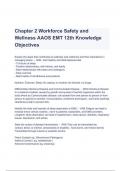Chapter
2
Workforce
Safety
and
Wellness
AAOS
EMT
12th
Knowledge
Objectives
Explain
the
steps
that
contributes
to
wellness
and
resilience
and
their
importance
in
managing
stress.
-
ANS
-
Eat
Healthy
and
Well
balanced
diet
-
7-9
hours
of
sleep
-
Positive
relationships,
with
friends,
and
family
-
Build
relationships
with
peers
and
colleagues
-
Daily
exercise
-
Build
habits
of
mindfulness
and
positivity
Nutrition,
Exercise,
Sleep,
No
vaping,
or
nicotine,
No
Alcohol,
no
drugs.
Differentiate
infectious
Disease
and
Communicable
Disease.
-
ANS
Infectious
Disease:
Is
a
medical
condition
caused
by
growth
and
spread
of
harmful
organisms
within
the
body
where
as
Communicable
disease:
can
spread
from
one
person
to
person
or
from
person
to
species
to
another .
Immunizations,
protective
techniques
,
and
hand
washing(
cleanliness)
help
to
prevent
this.
Identify
the
risks
and
hazards
of
sleep
deprivation
in
EMS.
-
ANS
Fatigue
can
lead
to
medical
errors
vehicle
crashes
,
harm
to
patients,
bystanders,
and
EMS
providers.
Longterm
sleep
deprivation
can
lead
to
hypertension,
sleep
apnea,
diabetes,
respiratory
issues,
depression,
and
stress.
State
the
routes
of
disease
transmission.
-
ANS
They
can
be
transmitted
by:
contact,
direct,
or
indirect,
aerosolized(
in
droplets)
,
food-borne,
and
Vector-borne(
Transmitted
through
insects
or
parasitic
worms.
Direct
Contact(
eg
,
Blood-borne
Pathogens)
Indirect
Contact
(
eg,
needlesticks
)
Airborne
transmission(
eg,
sneezing) Food-borne
transmission
(
eg,
contaminated
food)
Vector
Borne
transmission
(
eg,
fleas)
Describe
the
specific
routes
of
transmission
and
the
steps
to
prevent
and/or
deal
with
an
exposure
to
hepatitis,
tuberculosis,
or
human
immunodeficiency
(HIV)/acquired
immunodeficiency
disorder
(ADIS).
-
ANS
The
Specific
Routes
are
direct
contact
and
indirect
contact
and
airborne
transmission,
aswell
as
food
borne
transmission,
and
vector
borne
transmission.
The
steps
to
prevent
direct
contact
are
Donning
and
Duffing
Full
PPE,
proper
hand
hygiene,
gloves
,
Eye
protection,
and
face
Shields,
masks,
respirators
,
and
Barrier
Devices
,
proper
disposal
of
sharps,
employer
responsibilities,
cleaning,
and
decontaminating
,
immunizations.
Apply
the
standard
precautions
used
in
treating
patients
to
prevent
infection.
-
ANS
Component
hand
hygiene,
PPE,
Patient
Care
Environment,
and
special
circumstances.
Explain
the
steps
to
take
for
personal
protection
from
airborne
and
bloodborne
pathogens.
-
ANS
Step
1:
En
Route
to
the
scene
make
sure
that
PPE
is
out
and
available.
Step
2:
On
arrival,
identify
and
address
safety
hazards,
then
perform
a
rapid
scan
of
the
patient,
noting
wether
any
blood
or
body
fluids
are
present.
Select
the
proper
PPE
according
to
tasks
you
are
likely
to
perform.
typically
gloves
and
protective
eye
wear
will
be
used
for
all
patient
contacts.
Demonstrate
proper
handwashing
techniques.
-
ANS
-
wash
your
hands
before
and
after
contact
with
a
patient
even
if
you
wear
gloves.
-
Any
breaks
in
the
skin
such
as
tiny
cuts
and
abrasions
are
potential
access
points
for
pathogens.
Although
soap
and
water
are
not
protective
in
all
cases,
they
provide
excellent
protection
against
further
transmission
from
your
skin
to
others.
-
Rinse
your
hands
using
warm
water .
If
water
is
not
available
you
may
use
waterless
hand-
washing
substitutes.
-
Finally
,
dry
your
hands
with
a
paper
towel,
and
use
the
paper
towel
to
turn
off
the
faucet.
Explain
the
ways
in
which
immunity
to
infectious
disease
is
acquired.
-
ANS
-
One
way
to
gain
immunity
from
many
diseases
is
to
be
immunized,
or
vaccinated
against
them.




